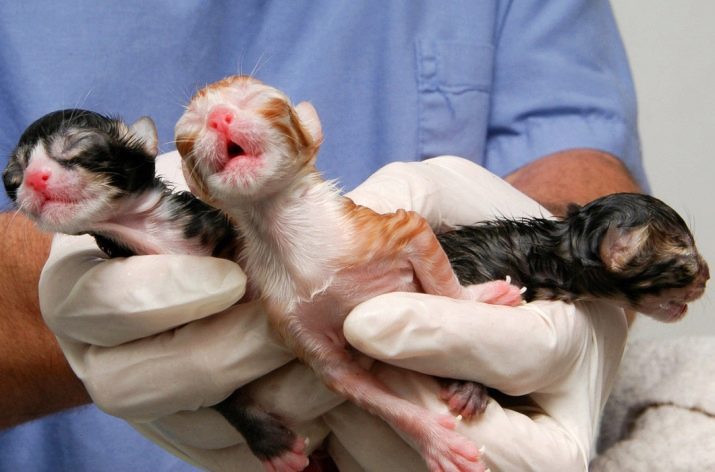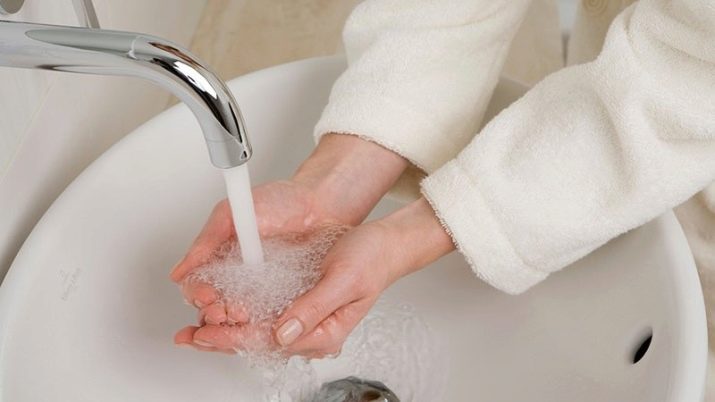How and what to feed a newborn kitten?

Like everything living in the world, a cat is not insured against death during childbirth, sudden loss (if the animal is beautiful and even thoroughbred, it can be taken away), falling under the wheels of a car, diseases, etc. But the kittens that she managed to produce on light, danger lies in wait from other animals, such as hungry dogs, as well as death from hunger and cold. The kittens were lucky if there were compassionate and caring people or neighboring cats who had not yet given birth, but did not reject other people's helpless kittens.

Why is cat milk ideal for offspring?
The cat produces special milk, in terms of fat content, it is noticeably lower than cow milk.
It contains:
- 80% water;
- 11% protein;
- lactose (sugar) - 3%;
- up to 6% fat;
- a small amount of vitamins.
This is the optimal ratio of water to dissolved nutrients, chosen by Mother Nature for growing cats and cats. A serious violation of such a balance in a kitten's diet increases the likelihood of growth retardation and weight gain, noticeably shortens the life span of an adult animal, and leads to the appearance of chronic diseases.

How does it grow?
A kitten is born blind and helpless, weighs only 100 grams, and is no larger than a rat. In the first week, he is not able to move far, because, in addition, he also does not know how to walk. The remainder of the umbilical cord, through which he received nutrients in the mother's womb, can remain during this week. After two weeks, his eyes open slightly, but not immediately - only by the 21st day of his life he is able to open them wide. The kitten's weight is doubled. By that time, the ears are also fully extended. At about the same time, he demonstrates his first teeth. By the end of the month, they all appear.
Also, the kitten walks confidently and weighs 300 grams.

Calling a veterinarian
If the cat has rejected the kittens or died in childbirth, immediately contact your veterinarian. He will correct the nutrition of newborns, bringing his recipe as close as possible to the natural composition, which will make it possible to feed babies without a cat without much hassle. Re-treatment will be required when the kittens do not gain weight and become ill. A sick kitten is transferred to a somewhat special supplementary feeding regimen.

Cat-free feeding
Try to find another lactating individual - yet the natural diet is superior to that created by humans. In other cases, the owner will have to temporarily become a substitute for the disappeared mother cat, organizing the kitten's access to nutritional mixtures at home.
First of all, find a place protected from dampness and draft for him.
What do you need?
If the kitten is not even a month old, you will need the following fixtures:
- syringe set - they perfectly dose the injected mixture;
- shatterproof pipette - suitable for point administration of drugs taken by mouth;
- bottle with pacifier - you can use the nursery, if there is no veterinary store nearby, any "drinking bowl" with a narrowed spout will do;
- measuring cup and spoon - the prepared mixture must be strictly dosed, avoiding starvation or overeating of the kitten;
- small bowl - the kitten will grow up soon, and he will need "adult" feeding.

Which products are suitable?
Store milk (cow's), whether dry or diluted, including dry cream, kefir, etc., will not suit a small kitten at all. As for the cats and cats of the "Sphynx" breed, even as adults, soon from its use they simply die. Other breeds of cats accept cow's milk and its derivatives, but only interspersed with the main diet, and not on an ongoing basis.

Use special nutritional formula that is very similar in composition to cat's milk. They will spur significantly the growth of kittens. Quite good products are supplied by, for example, Royal Canin, Hartz or Katzenmilch, often using compatible substitutes, even suitable for puppies and baby ferrets. But these eminent manufacturers supply expensive products. Fortunately, there are alternatives, such as diluted unsweetened condensed milk with added bone meal, milk and egg mixture (no proteins) with a little vegetable oil, and a few other options.
As a temporary measure, black bread soaked to the state of a watery gruel is also suitable.

Preparing and storing the formula
Be sure to wash (sterilize if possible) all utensils as if you were feeding babies. Wash your hands thoroughly.
Before starting feeding, the mixture must be carefully prepared, following the recipe. Thickening of the mixture will lead to indigestion, too watery composition - to premature starvation, malnutrition of the kitten and, as a result, to its slowed down growth.
After 6 hours, the cooked mixture becomes overexposed - even if frozen and re-thawed, it will lead to biological stress when it is absorbed. The temperature of the mixture cannot be lower than 37 degrees. If not, heat it up.

How to feed a newborn kitten?
For best results, massage the kitten for a few minutes, stroking her head and back. Best of all, the kitten will eat, or rather, drink this mixture from the nipple. It is not recommended to solder it with a "naked" syringe or using a drinking spoon: it may choke if swallowed. Exception: your actions must be so precise that at one time you will inject the kitten no more than 0.1 "cube" on the scale applied to the syringe. If the syringe is so bad that the plunger jerks with each press and creates fountains, replace it or still use a teat.
Accidental hit of even a drop of the nutrient composition will lead to the fact that it will choke or pneumonia will develop. It should be in a vertical or semi-horizontal position.

Continue feeding him until he is full - after receiving the mixture, he will calm down and fall asleep. The mixture should not be carbonated (airy). After the end of feeding, you should hold it vertically for several minutes - the remains of the mixture swallowed by the kitten will completely drain from the esophagus into the stomach.
The feeding schedule is shortened as the kitten "grows up":
- the first 4 days of life after birth, feeding is carried out every 2 hours, 1 ... 1.5 ml, in the remainder of the first week, 4.5 ml are given 7 times a day;
- in the second week, the kitten drinks 9 ml 6 times, in the 3rd - 15 ml 5 times, in the 4th - 20 ml also 5 times;
- in the 5th and 6th week, 25 ml of the mixture is required 4 times a day.

After that, the kitten is gradually transferred to the general cat diet, and night feeding is finally removed from the schedule. Maine Coon, Savannah, Pixie Bob or Kurilian Bobtail, you can feed several large doses.
The fact that you are doing everything right is evidenced by the calm behavior of the kitten. But if you forget to feed him, he will immediately remind you of himself. Track the dynamics of weight gain with averages.
Newborn kittens, who are not even a week old, as well as weakened and sick kittens, can be fed with the "Baby" formula, using the "Nutrilon" infant formula and liquid vitamin complexes in drops for its preparation.
Examples of commercial feline mixtures that can replace a real cat's breast milk:
- vitamin milk with taurine Gimpet Cat-Milk;
- Royal Canin Babycat Milk;
- Nutri-Vet Kitten Milk;
- Kittenmilch CdVet;
- Gimcat.


Self-feeding age
From the age of one month, kittens can be fed complementary foods, while feeding should not be interrupted. At first, baby puree with the addition of minced meat is suitable. And although a cat is a predator, do not rush to give it natural meat or fish until it can digest it.
For comparison: stray cats that eat anything from the first month, as a rule, do not live more than 7–8 years, although they could live more than 10 years.

After 1.5 months of a kitten's life, you can cancel nutritional mixtures, replacing them with ordinary milk, grated and boiled vegetables, softened black bread. It is not recommended to give him white bread and egg white, rolls and sweets - the digestion and metabolism of a cat is significantly different from that of a human. Although a cat from chronic starvation will even eat ice cream, such barbaric experiments - especially on an empty stomach - will soon "plant" its liver and pancreas, and without immediate treatment, the animal will soon wither away. If the kitten is purebred, look for an alternative food: its body is unlikely to cope with such foods as raw meat or fish, milk and bread - the kitten will simply vomit from such food. Never overfeed a kitten at any age with solid food, such as dry food, leaving an open bag in an easily accessible place. He will overeat (cats do not know the measure), and this is guaranteed to cause him constipation, here the help of a veterinarian will already be required.

If there is an opportunity to buy real dry food, and not cheap fakes for it, take this opportunity. Poor nutrition, as well as an overdose of the daily feeding rate, will lead, for example, to premature liver hypertrophy and cystitis. Also, the kitten should receive a sufficient amount of water - do not forget about this.
See below for kitten feeding.
































